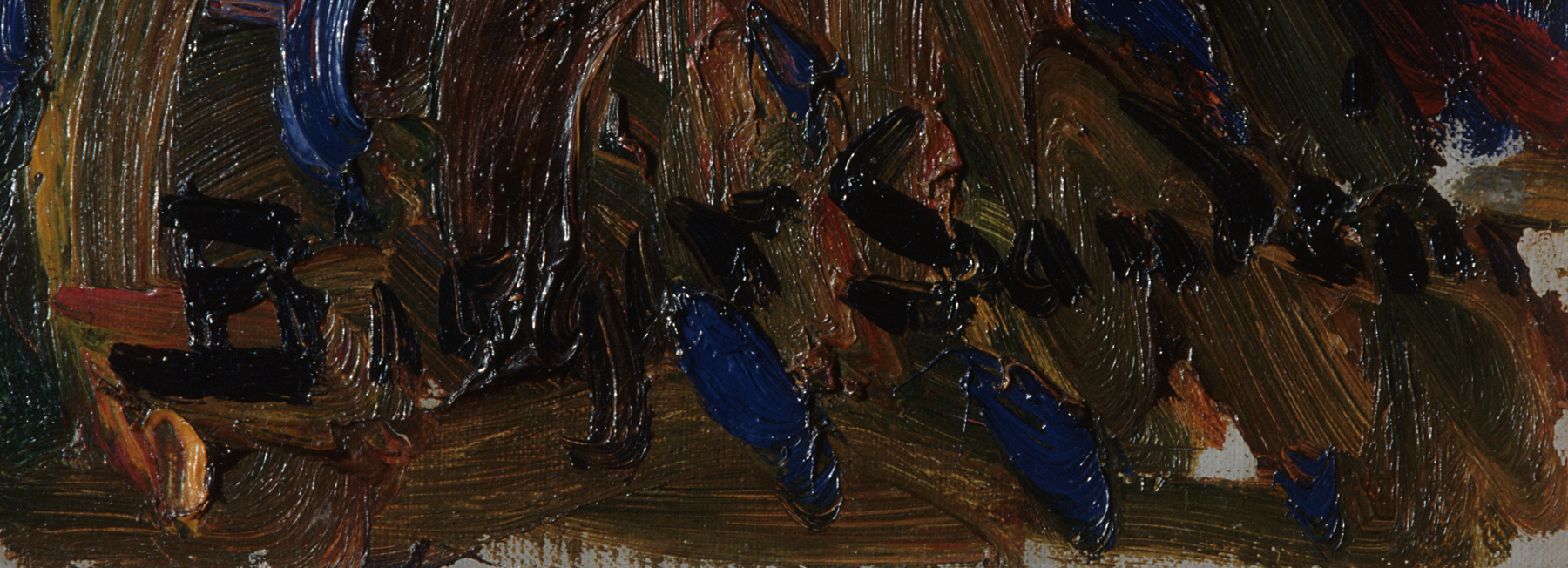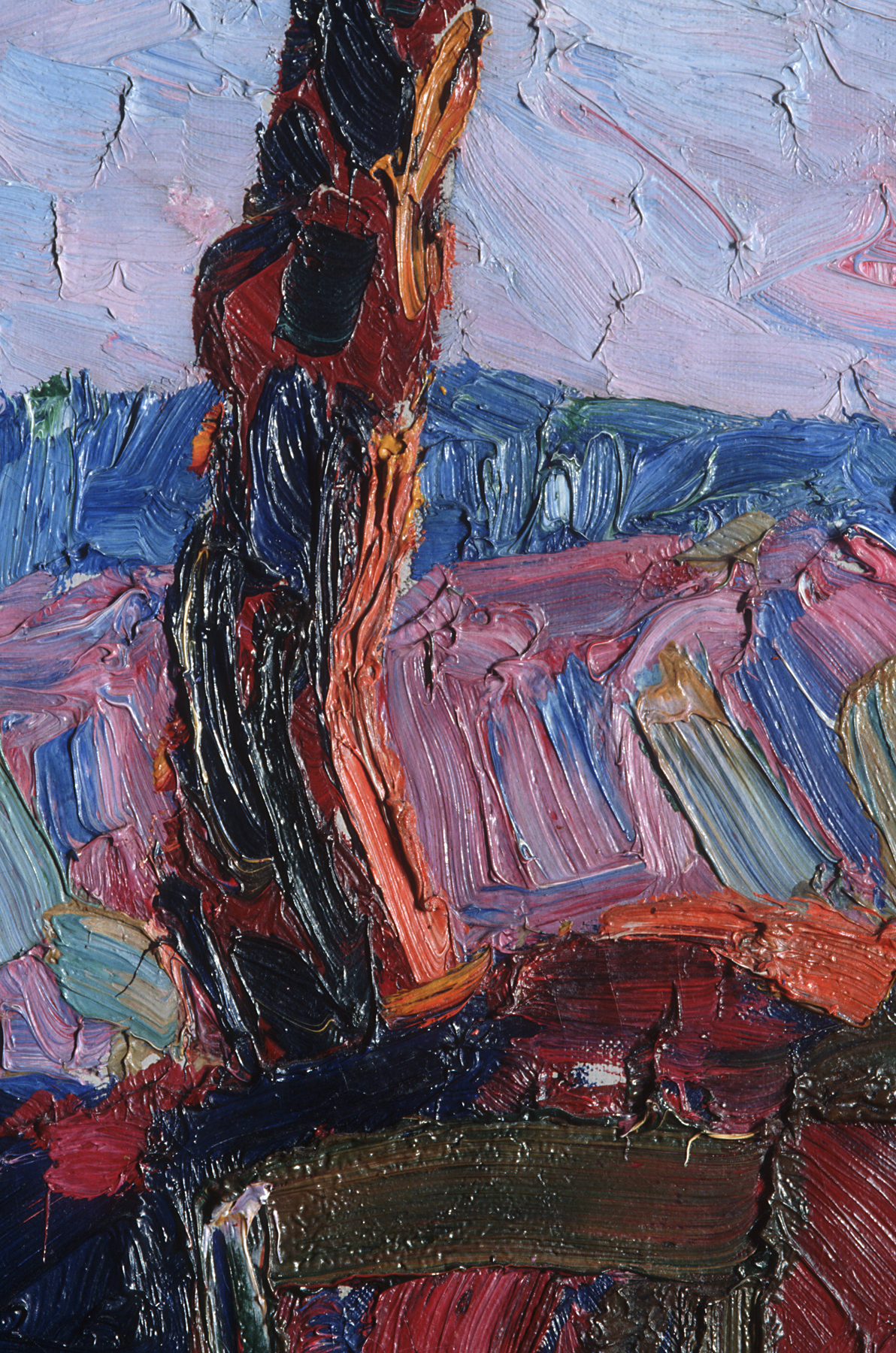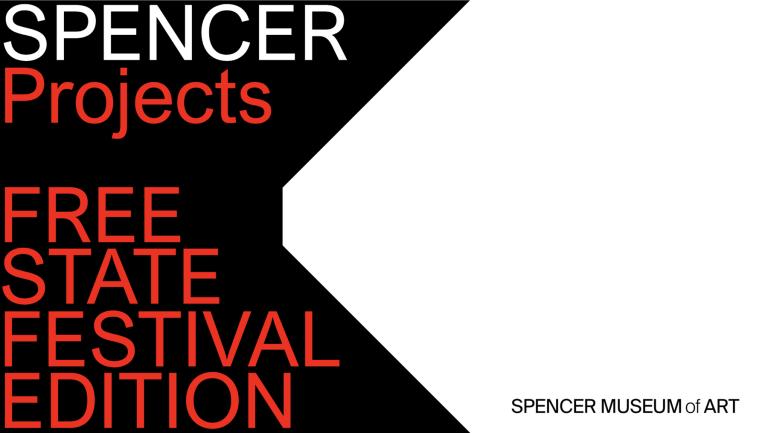Landscape with Four Trees, Birger Sandzén
Artwork Overview
Canvas/Support (Height x Width x Depth): 121.3 x 90.6 cm
Canvas/Support (Height x Width x Depth): 47 3/4 x 35 11/16 in
Frame Dimensions (Height x Width x Depth): 56 x 43 1/2 in
If you wish to reproduce this image, please submit an image request
Images
Label texts
The four rough trees in the foreground of this landscape frame the setting sun. Or is it a rising moon? The sky is a blend of blues, pinks, and oranges. The light from the sun shines on the backs of the trees, creating dark silhouettes against the bright sky.
The artist Birger Sandzén moved to Kansas from Sweden in 1894. The Kansas landscape was often the subject of his paintings and prints, but he also liked the mountains and trees of Colorado. This is a painting of the Rocky Mountains in Colorado.
How can you tell that this painting represents Colorado and not Kansas?
Before his immigration to the United States, Sandzen studied in Stockholm with the noted painter–etcher Anders Zorn. After two years as Zorn’s student, Sandzen traveled to Paris in the winter of 1893–1894. In Paris he discovered the pointillist technique and divisionist color theories that he incorporated into his art. Landscape with Four Trees, a Rocky Mountain scene, exemplifies his debt to these French influences. Sandzen placed bold pigments on the canvas juxtaposed with such precision that the color mixing is done optically—by the eye of the viewer—rather than on the artist’s palette.
Click on the audio tab above to listen to a student's interpretation of this object.
Birger Sandzen came to Bethany College in Lindsborg, Kansas in September of 1894 after reading I Sverige (1890). This book, written by the president of the college, Dr. Carl Swensson, described the founding of Bethany College by Swedish immigrants on the plains of central Kansas and inspired Sandzen to emigrate.
Before his immigration to the United States, Sandzen studied in Stockholm with the noted painter-etcher Anders Zorn. After two years as Zorn’s student, Sandzen traveled to Paris in the winter of 1893-94. In Paris he discovered the pointillist technique and divisionist color theories of Seurat and Aman-Jean, which he incorporated into his art. Landscape with Four Trees, a Rocky Mountain scene, exemplifies his debt to these French influences. Sandzen placed bold pigments on the canvas juxtaposed with such precision that the color mixing is done optically-by the eye of the viewer-rather than on the artist’s palette.
Birger Sandzen came to Bethany College in Lindsborg, Kansas in September of 1894 after reading I Sverige (1890). This book, written by the president of the college, Dr. Carl Swensson, described the founding of Bethany College by Swedish immigrants on the plains of central Kansas and inspired Sandzen to emigrate.
Before his immigration to the United States, Sandzen studied in Stockholm with the noted painter-etcher Anders Zorn. After two years as Zorn’s student, Sandzen traveled to Paris in the winter of 1893-94. In Paris he discovered the pointillist technique and divisionist color theories of Seurat and Aman-Jean, which he incorporated into his art. Landscape with Four Trees, a Rocky Mountain scene, exemplifies his debt to these French influences. Sandzen placed bold pigments on the canvas juxtaposed with such precision that the color mixing is done optically-by the eye of the viewer-rather than on the artist’s palette.
Before his immigration to the United States, Sandzen studied in Stockholm with the noted painter–etcher Anders Zorn. After two years as Zorn’s student, Sandzen traveled to Paris in the winter of 1893–1894. In Paris he discovered the pointillist technique and divisionist color theories that he incorporated into his art. Landscape with Four Trees, a Rocky Mountain scene, exemplifies his debt to these French influences. Sandzen placed bold pigments on the canvas juxtaposed with such precision that the color mixing is done optically—by the eye of the viewer—rather than on the artist’s palette.
Didactic label content here.
Birger Sandzen came to Bethany College in Lindsborg, Kansas in September of 1894 after reading I Sverige (1890). This book, written by the president of the college, Dr. Carl Swensson, described the founding of Bethany College by Swedish immigrants on the plains of central Kansas and inspired Sandzen to emigrate.
Before his immigration to the United States, Sandzen studied in Stockholm with the noted painter-etcher Anders Zorn. After two years as Zorn’s student, Sandzen traveled to Paris in the winter of 1893-94. In Paris he discovered the pointillist technique and divisionist color theories of Seurat and Aman-Jean, which he incorporated into his art. Landscape with Four Trees, a Rocky Mountain scene, exemplifies his debt to these French influences. Sandzen placed bold pigments on the canvas juxtaposed with such precision that the color mixing is done optically-by the eye of the viewer-rather than on the artist’s palette.
Birger Sandzen came to Bethany College in Lindsborg, Kansas in September of 1894 after reading I Sverige (1890). This book, written by the president of the college, Dr. Carl Swensson, described the founding of Bethany College by Swedish immigrants on the plains of central Kansas and inspired Sandzen to emigrate.
Before his immigration to the United States, Sandzen studied in Stockholm with the noted painter-etcher Anders Zorn. After two years as Zorn’s student, Sandzen traveled to Paris in the winter of 1893-94. In Paris he discovered the pointillist technique and divisionist color theories of Seurat and Aman-Jean, which he incorporated into his art. Landscape with Four Trees, a Rocky Mountain scene, exemplifies his debt to these French influences. Sandzen placed bold pigments on the canvas juxtaposed with such precision that the color mixing is done optically-by the eye of the viewer-rather than on the artist’s palette.
Archive Label 2003:
Birger Sandzen came to Bethany College in Lindsborg, Kansas in September of 1894 after reading I Sverige (1890). This book, written by the president of the college, Dr. Carl Swensson, described the founding of Bethany College by Swedish immigrants on the plains of central Kansas and inspired Sandzen to emigrate.
Before his immigration to the United States, Sandzen studied in Stockholm with the noted painter-etcher Anders Zorn. After two years as Zorn’s student, Sandzen traveled to Paris in the winter of 1893-94. In Paris he discovered the pointillist technique and divisionist color theories of Seurat and Aman-Jean, which he incorporated into his art. Landscape with Four Trees, a Rocky Mountain scene, exemplifies his debt to these French influences. Sandzen placed bold pigments on the canvas juxtaposed with such precision that the color mixing is done optically-by the eye of the viewer-rather than on the artist’s palette.
Exhibitions
Rachel Straughn-Navarro, curator













